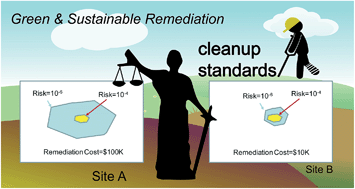当前位置:
X-MOL 学术
›
Environ. Sci.: Processes Impacts
›
论文详情
Our official English website, www.x-mol.net, welcomes your feedback! (Note: you will need to create a separate account there.)
Targeting cleanups towards a more sustainable future
Environmental Science: Processes & Impacts ( IF 5.5 ) Pub Date : 2017-12-22 00:00:00 , DOI: 10.1039/c7em00518k David O'Connor 1, 2, 3, 4 , Deyi Hou 1, 2, 3, 4
Environmental Science: Processes & Impacts ( IF 5.5 ) Pub Date : 2017-12-22 00:00:00 , DOI: 10.1039/c7em00518k David O'Connor 1, 2, 3, 4 , Deyi Hou 1, 2, 3, 4
Affiliation

|
A tension arises between society's disposition to protect people at risk from environmental pollution, and an aversion towards the potential harmful side-effects associated with cleanup activities. Here we explore how setting different cleanup standards may influence some of the environmental, social, and economic side-effects of remediation, and how they can be quantified for incorporation into cleanup target setting; these include (1) secondary environmental impacts, assessed by life cycle assessment (LCA); (2) fatalities and injuries, assessed by actuarial risk analysis; and (3) the cost effectiveness of stringent cleanup standards, assessed by the incremental cost-effectiveness ratio (ICER). We argue that only by using optimal cleanup standards that integrate quantified remediation side-effects with health risk assessment (HRA) can the green and sustainable remediation (GSR) movement maximize its potential. Together, the combined approaches may provide a more holistic management of risks for a more sustainable future.
中文翻译:

面向更可持续发展的未来进行清理
社会在保护处于危险中的人免受环境污染的倾向与对与清理活动相关的潜在有害副作用的厌恶之间产生了紧张关系。在这里,我们探讨设置不同的清理标准如何影响补救的某些环境,社会和经济副作用,以及如何量化它们以纳入清理目标设置;其中包括:(1)通过生命周期评估(LCA)评估的次要环境影响;(2)死亡和受伤,通过精算风险分析进行评估;(3)严格的清理标准的成本效益,以增量成本效益比(ICER)进行评估。我们认为,只有通过使用将量化的补救措施副作用与健康风险评估(HRA)集成在一起的最佳清理标准,绿色环保的可持续补救措施(GSR)才能发挥其最大潜力。总之,组合的方法可以提供更全面的风险管理,以实现更可持续的未来。
更新日期:2017-12-22
中文翻译:

面向更可持续发展的未来进行清理
社会在保护处于危险中的人免受环境污染的倾向与对与清理活动相关的潜在有害副作用的厌恶之间产生了紧张关系。在这里,我们探讨设置不同的清理标准如何影响补救的某些环境,社会和经济副作用,以及如何量化它们以纳入清理目标设置;其中包括:(1)通过生命周期评估(LCA)评估的次要环境影响;(2)死亡和受伤,通过精算风险分析进行评估;(3)严格的清理标准的成本效益,以增量成本效益比(ICER)进行评估。我们认为,只有通过使用将量化的补救措施副作用与健康风险评估(HRA)集成在一起的最佳清理标准,绿色环保的可持续补救措施(GSR)才能发挥其最大潜力。总之,组合的方法可以提供更全面的风险管理,以实现更可持续的未来。



























 京公网安备 11010802027423号
京公网安备 11010802027423号